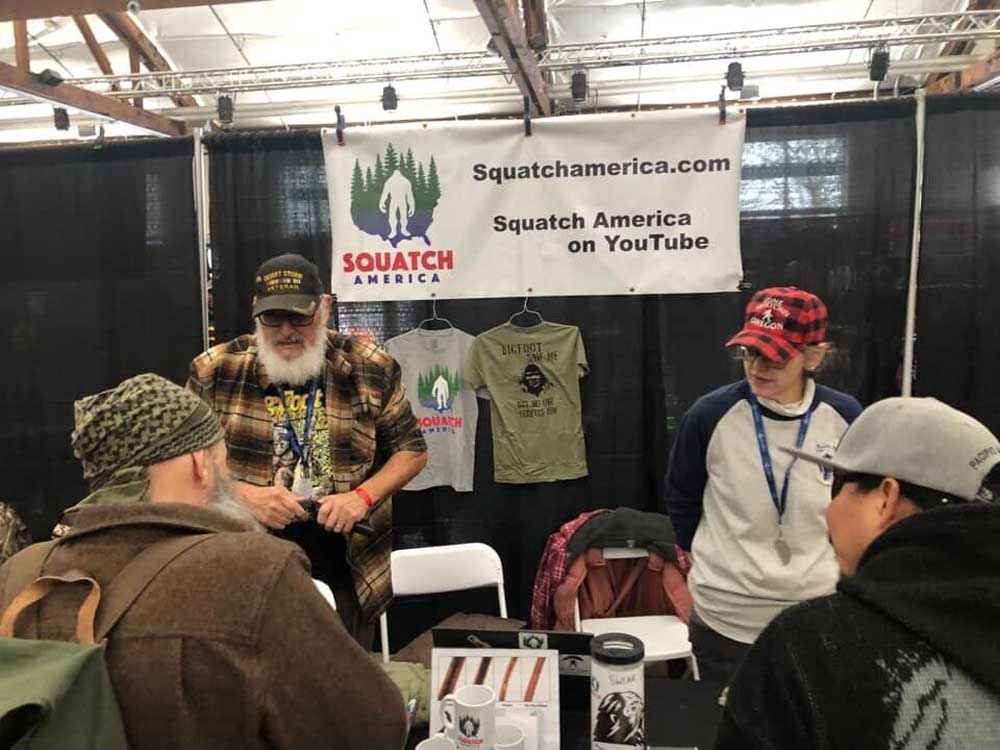Bigger and bigger yet: Bigfoot festival host looks forward to sharing legends
Published 1:00 pm Wednesday, April 17, 2024

- Scot and Hannah Violette manning their Squatch America booth.
BAKER CITY — Stories have always had a way of becoming more elaborate and fanciful over time, but conversely, some of the most ancient stories were etched into rock as singular symbols.
Anthropologist Scot Violette’s passion is focused on one figure that repeats not only throughout history, but in the annals of virtually every native tongue.
“My expertise is in Native American cultures,” said Violette, speaking remotely via Zoom from somewhere in the Oregon wilderness. “Every tribe in the nation has a bigfoot legend.”
Wood Apes, Sasquatch, some might even let fly with Yeti. There are many names and a lot to be said about the public’s fascination with hairy woodland wanderers, and personal accounts as far back as prehistoric times.
For Violette stories are where it all starts, but evidence, methods and proof are still his gold standard, and he hopes that one day he gets his chance to study the real thing.
Violette has spent decades moving from region to region to learn the legends and names associated with Bigfoot, and thoroughly explored the wilds they’re rumored to roam, collecting any and all compelling data on what he hopes may be proof of a real species.
“I’ve worked in Chaco Canyon, New Mexico, worked with the Miwuk tribe of central California in Yosemite Valley,” said Violette. Chaco Canyon, notably, is a Pueblo heritage site and a famous ruin over 1,100 years old.
“Lots of tribes had different relationships with them, some had trade treaties with them, other tribes had wars with them, depending on the tribe,” he said. “I think they’re a whole different hominid branch, but they’re more of an ape.”
There is fossil precedent for such creatures, in fact, something Violette is well aware of in his work. Remains of Gigantopithecus, the giant ape that lived in ancient China, indicate the existence of a powerful species plausibly 9 feet tall and weighing roughly a quarter-ton, one closely related to orangutans.
As well, some of the most ancient evidence for human existence in the Americas goes back 23,000 years. In those eras, geology suggests there was a land bridge between Alaska and Asia at the end of the Pleistocene.
Violette says there is some potential for such a creature to have arrived as ancient humans did, by simply walking across the Atlantic some 37,000 years ago.
More locally, Violette says that stone pictographs, left behind by possibly Nez Perce or Paiute tribes, warned travelers to avoid the area, indicating the presence of a very large humanoid creature.
Tools of the tradeDespite the popularity of the hunt, as yet bigfoot researchers have yet to secure the ultimate evidence: a living specimen.
Certainly there have been several hoaxes involving costumes, animatronics and even taxidermy, most of which are found out sooner than later.
To that end, Violette has collected a variety of findings, footprint molds, improvised nests, even partially eaten carcasses suspended in trees, but says he isn’t intent to capture or kill what he thinks could be sapient creatures on par with early humans.
He catalogs his research regularly, and illustrates his work on his website.
Violette says he relies on a bevy of instruments, many attached to his official Squatchmobile, a heavily customized vehicle he takes on his expeditions. In itself it’s an attraction he features at the annual Blue Mountain Bigfoot Festival.
“Tent, water, food, infrared cameras, a microphone recording 24/7 audio, a 360 degree camera, Starlink internet,” said Violette, elaborating on what’s built into his rig. He wears similar cameras whenever he is hiking on foot as well.
Though drones are very useful for surveillance, they often sound like angry bees to animals, forcing them to hide, and Violette says he doesn’t rely on them.
He has networked trailcams as well, which can link through to each other in an array, such as along lengths of crucial wild waterways, and monitor long stretches of territory wirelessly.
Sharing legendsViolette states his business front and center on his website: Investigating the Unexplained, Not Explaining the Uninvestigated.
Violette draws passion from his own Bigfoot encounter, which he says took place while exploring with a new friend in 2018, and many years after he’d committed his life to the research.
“I have had a sighting myself,” he said, “and recently we got my blurry photo enhanced and it looks pretty good!”
The image, taken through boughs of pine trees on a summer day, appears to contain the shapely contours of a face.
“We were hiking up the trail, and we smelled the most horrible smell,” said Violette, a sign he said he’d heard from other accounts. “Then we stopped in our tracks, and were trying to detect where it was coming from.”
Violette says he growled audibly, and when something responded in kind he managed to approach it and snap the photograph, which he believes to be of a juvenile Bigfoot.
“I saw it for the first time, and I’ve been doing this for 25 years,” he said.
He shares his story, and his discoveries, in depth at the increasingly popular Blue Mountain Bigfoot Festival in Baker City, which he puts on with his wife, Hannah.
The event will be accompanied by author Robert Leiterman, musician and Bigfoot researcher Tom Bennett, and presenter Jeremy Scott from the “Into the Parabnormal” podcast.
If you’d like to share your own story or perhaps take up the hunt, the Bigfoot festival enters its third year as it returns this June 21-23. As well, Violette’s website, SquatchAmerica.com, keeps updates on his findings and events.
The festival brought nearly 2,000 people to the valley in 2023, and Violette thinks that, like the legends, it will continue to grow.









